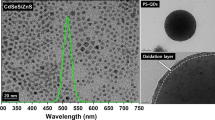Abstract
The development of photoluminescent materials based on the incorporation of quantum dots (QDs) into polymeric latexes has gained importance due to the multiple potential applications. Through the process of miniemulsion polymerization it is possible to encapsulate quantum particles into polymer matrix to provide both chemical stability and to maintain emission properties. The polymerization process was achieved with continuous magnetic stirring and nitrogen atmosphere. Cetyl trimethylammonium bromide (CTAB) was used as surfactant at concentration levels of 1.3 × 10-3, 3.2 × 10-3 and 5.4 × 10-3 M. The initiator 2,2-azobisisobutyronitrile (AIBN) was used at 0.50 and 0.75 wt% and CdSe QDS were used at 0.075, 0.15 and 0.225 wt%, both in relation to monomer content. A STEM study on the composite latexes and later a statistical study on the measurement of polymer particle diameter let us corroborate that the increment in surfactant concentration produces a decrement in polymer particle size. The obtained composite latexes were stable and showed fluorescence by excitation with UV light. The spectrofluorometry studies indicated that in composite latexes fluorescent emission was a function of polymer particle size, showing higher intensity those formulations with smaller surfactant concentrations and bigger polymer particle size.







Similar content being viewed by others
References
Galian RE, De la Guardia M (2009) The use of quantum dots in organic chemistry. Trends in Analytical Chemistry 28:3
Bailey RE, Smith AM, Nie S (2004) Quantum dots in biology and medicine. Physica E: Low-dimensional Systems and Nanostructures 25:1
Jamieson T, Bakhshi R, Petrova D, Pocock R, Imani M, Seifalian AM (2007) Biological applications of quantum dots. Biomaterials 28:4717
Dridi C, Haouari M, Ouada HB, Legrand A-P, Davenas J, Bernard M, André J-J, Sai AH, Mattoussi F (2006) Spectroscopic investigations on hybrid nanocomposites: CdS: Mn nanocrystals in a conjugated polymer. Materials Science and Engineering: C 26:415
Zhou C, Shen H, Gou Y, Xu L, Niu J, Zhang Z, Du Z, Chen J, Li LS (2010) A versatile method for the preparation of water-soluble amphiphilic oligomer-coated semiconductor quantum dots with high fluorescence and stability. Journal of Colloid and Interface Science 344:279–285
Joumaa N, Elaissari A, Lansalot M, Sukhanova A, Artemyev M, Nabiev I, Cohen J (2005) Synthesis of fluorescent latexes by miniemulsión polymerization. Proceeding 8th Polymers Advanced Technologies International Symposium. Budapest, Hungary
Yang X, Zhang Y (2004) Encapsulation of Quantum nanodots in polystyrene and silica micro-/nanoparticles. Langmuir 20:6071
Yang Y, Wen Z, Dong Y, Gao M (2006) Incorporating CdTe nanocrystals into polystyrene microspheres: towards robust fluorescent beads. Small 2(7):898
Sheng W, Kim S, Lee J, Kim S-W, Jensen K, Bawendi MG (2006) In-situ encapsulation of quantum dots into polymer microspheres. Langmuir 22:3782
Sharma H, Sharma SN, Singh G, Shivaprasad SM (2007) Studies of optical and structural properties of CdSe/polymer nanocomposites: evidence of charge transfer and photostability. Colloid & Polymer Science 285:213
Kietzke T, Neher D, Landfester K, Montenegro R, Gutner R, Scerf U (2003) Novel approaches to polymer blends based on polymer nanoparticles. Nature Materials 2:408–412
Mohanta D, Mishra NC, Choudhury A (2004) SHI- induced grain growth and grain fragmentation effects in polymer-embedded CdS quantum dot systems. Materials Letters 58:3694
Hofstraat JW, Verhey HJ, Verhoeven JW, Kumke MU, Li G, Hemmingsen SL, McGown LB (1997) Fluorescence lifetime studies of labeled polystyrene lattices. Polymer 38(12):2899–2906
Schork FJ, Luo Y, Smulders W, Russum JP, Butté A, Fontenot K (2005) Miniemulsion Polymerization. Advances in Polymer Science 175:129
Landfester K (2001) Polyreactions in miniemulsions. Macromolecular Rapid Communications 22:12
Vassiltsova OV, Zhao Z, Petrukhina MA, Carpenter MA (2007) Surface-functionalized CdSe quantum dots for the detection of hydrocarbons. Sensors and Actuators B: Chemical 123:522
Odian G (1991) Principles of polymerization, 3rd edn. Wiley, New York
Ravera F, Ferrari M, Liggieri L, Loglio G, Santini E, Zanobini A (2008) Liquid-liquid interfacial properties of mixed nanoparticle-surfactant systems. Colloids and Surfaces A 323:99
Myers D (1992) Surfactant science and technology, 2nd edn. VCH, New York
Antonietti M, Landfester K (2002) Polyreactions in miniemulsions. Progress in Polymer Science 27:689
Miller CM, Sudol ED, Silebi CA, El-Aasser MS (1995) Capillary hydrodynamic fractionation (CHDF) as a tool for monitoring the evolution of the particle size distribution during miniemulsión polymerization. Journal of Colloid and Interface Science 172:249
Joumma N, Lansalot M, Théretz A, Elaissari A, Sukhanova A, Artemyev M, Nabiev I, Cohen JHM (2006) Synthesis of quantum dot-tagged submicrometer polystyrene particles by miniemulsion polymerization. Langmuir 22:1810
Costa-Fernandez J, Pereiro R, Sanz-Medel A (2006) The use of luminescent quantum dots for optical sensing. Trends in Analytical Chemistry 25:3
Khanna PK, Singh N (2007) Light emitting CdSe quantum dots in PMMA: synthesis and optical studies. Journal of Luminescence 127:474
Noh M, Kim T, Lee H, Kim C, Joo S, Lee K (2010) Fluorescence quenching caused by aggregation of water-soluble CdSe quantum dots. Colloids and Surfaces A 359:39
Acknowledgement
Authors wish to thank the National Council for Science and Technology of Mexico (CONACyT) for the grand awarded to Anilú Rubio Ríos.
Author information
Authors and Affiliations
Corresponding author
Rights and permissions
About this article
Cite this article
Rubio-Ríos, A., Aguilar-Castillo, B.A., Flores-Gallardo, S. et al. Effect of synthesis variables on the fluorescence properties of CdSe-polystyrene latexes. J Polym Res 19, 9833 (2012). https://doi.org/10.1007/s10965-012-9833-5
Received:
Accepted:
Published:
DOI: https://doi.org/10.1007/s10965-012-9833-5



